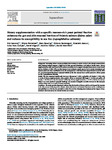Dietary supplementation with a specific mannan-rich yeast parietal fraction enhances the gut and skin mucosal barriers of Atlantic salmon (Salmo salar) and reduces its susceptibility to sea lice (Lepeophtheirus salmonis)
| dc.contributor.author | Leclercq, E | |
| dc.contributor.author | Pontefract, N | |
| dc.contributor.author | Rawling, Mark | |
| dc.contributor.author | Valdenegro, V | |
| dc.contributor.author | Aasum, E | |
| dc.contributor.author | Andujar, LV | |
| dc.contributor.author | Migaud, H | |
| dc.contributor.author | Castex, M | |
| dc.contributor.author | Merrifield, Daniel | |
| dc.date.accessioned | 2021-12-09T17:01:13Z | |
| dc.date.available | 2021-12-09T17:01:13Z | |
| dc.date.issued | 2020-12 | |
| dc.identifier.issn | 0044-8486 | |
| dc.identifier.issn | 1873-5622 | |
| dc.identifier.other | 735701 | |
| dc.identifier.uri | http://hdl.handle.net/10026.1/18451 | |
| dc.description.abstract |
Increasing reliance on non-medicinal interventions to control sea lice in the Atlantic salmon (Salmo salar) farming industry imposes a high level of skin mucosal disturbance and indirect health issues. Dietary supplementation with yeast-based MOS products is widely used to support intestinal homeostasis across farmed species. Evidence of their effect on skin mucosa is increasing in aquatic species but it remains inconsistent and someway short of a clear contribution to sea lice management. A tank-based trial was performed to test the effect of a yeast-based MOS functional compound (sMOS) on the skin mucosal layer and its protective effects against sea lice (Lepeophtheirus salmonis).The test compound significantly increased skin mucus (+46%) and goblet cell density (+25%) after 6 weeks of dietary supplementation when positive effects on intestinal villi-length (+10.9%) and goblet cell density (+80.0%) were also documented. Following dietary supplementation, a 16.6% reduction in susceptibility to an acute standard copepodid challenge was measured alongside an earlier increase in skin lysozyme activity widely used as an index of innate immunity.The study provides functional evidence that the benefits of dietary sMOS reach beyond the intestine to the skin mucosa. Bolstering of the Atlantic salmon skin barrier and immune functions and the resulting lower susceptibility to sea lice has the potential to reduce the need for delousing interventions and the impact of non-medicinal interventions on the animal's health and welfare. | |
| dc.format.extent | 735701-735701 | |
| dc.format.medium | Undetermined | |
| dc.language | en | |
| dc.language.iso | en | |
| dc.publisher | Elsevier BV | |
| dc.subject | Atlantic salmon | |
| dc.subject | Functional ingredient | |
| dc.subject | Mucosal health | |
| dc.subject | Sea lice | |
| dc.subject | Skin mucous | |
| dc.subject | Yeast cell wall | |
| dc.title | Dietary supplementation with a specific mannan-rich yeast parietal fraction enhances the gut and skin mucosal barriers of Atlantic salmon (Salmo salar) and reduces its susceptibility to sea lice (Lepeophtheirus salmonis) | |
| dc.type | journal-article | |
| dc.type | Journal Article | |
| plymouth.author-url | https://www.webofscience.com/api/gateway?GWVersion=2&SrcApp=PARTNER_APP&SrcAuth=LinksAMR&KeyUT=WOS:000566468000024&DestLinkType=FullRecord&DestApp=ALL_WOS&UsrCustomerID=11bb513d99f797142bcfeffcc58ea008 | |
| plymouth.volume | 529 | |
| plymouth.publication-status | Published | |
| plymouth.journal | Aquaculture | |
| dc.identifier.doi | 10.1016/j.aquaculture.2020.735701 | |
| plymouth.organisational-group | /Plymouth | |
| plymouth.organisational-group | /Plymouth/Faculty of Science and Engineering | |
| plymouth.organisational-group | /Plymouth/Faculty of Science and Engineering/School of Biological and Marine Sciences | |
| plymouth.organisational-group | /Plymouth/REF 2021 Researchers by UoA | |
| plymouth.organisational-group | /Plymouth/REF 2021 Researchers by UoA/UoA06 Agriculture, Veterinary and Food Science | |
| plymouth.organisational-group | /Plymouth/Users by role | |
| plymouth.organisational-group | /Plymouth/Users by role/Academics | |
| plymouth.organisational-group | /Plymouth/Users by role/Researchers in ResearchFish submission | |
| dc.identifier.eissn | 1873-5622 | |
| dc.rights.embargoperiod | Not known | |
| rioxxterms.versionofrecord | 10.1016/j.aquaculture.2020.735701 | |
| rioxxterms.licenseref.uri | http://www.rioxx.net/licenses/all-rights-reserved | |
| rioxxterms.type | Journal Article/Review |


